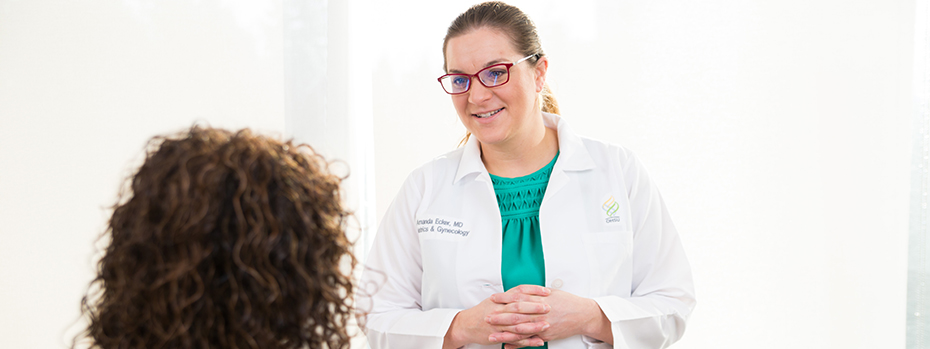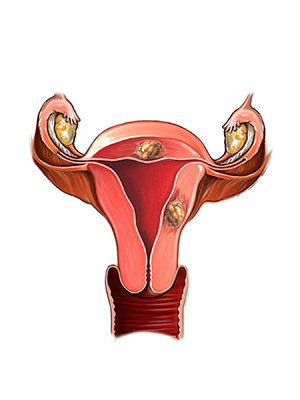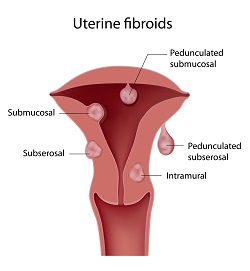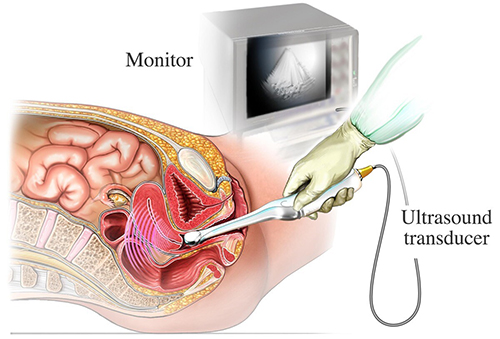Fibroid Treatment

The OHSU Center for Women’s Health provides advanced care for people with uterine fibroids.
We offer:
- Personalized care with providers who prioritize your goals and consider the full range of available treatments.
- Expert gynecologists and radiologists with additional training in minimally invasive procedures to treat fibroids, so you can recover faster.
- Advanced imaging tools for detailed diagnosis and treatment.
- The latest technology and techniques to remove fibroids and manage your symptoms.
- Team-based care, including access to fertility specialists to explore your options for having children.
Complete care
At the Center for Women’s Health, we bring together experts in a variety of fields to focus on your care. Our fibroids team makes it a priority to share with you all of the possible strategies for treating your condition.
The team meets regularly to review cases, share expertise and develop treatment plans based on each patient’s needs. We learn from the latest advances in fibroids research and bring in experts from across OHSU for other services as needed.
Your team may include specialists such as:
- Gynecologists with exceptional skill and advanced training in surgery for fibroids.
- Interventional and diagnostic radiologists for minimally invasive procedures to identify or shrink fibroids.
- Experts in reproductive endocrinology, fertility and maternal-fetal medicine to talk about options if you want to have children.
- Other providers depending on your needs and care plan. For example, you may see an acupuncturist to help with pain.
Understanding fibroids

Fibroids are very common, but often cause no symptoms or problems. For some women, fibroids cause pain or heavy bleeding that impacts their daily lives.
Medical Illustration Copyright © 2023 Nucleus Medical Media. All rights reserved.
For patients
Call 503-418-4500 to make an appointment.
Location
OHSU Center for Women’s Health, Marquam Hill
Kohler Pavilion, seventh floor
808 S.W. Campus Drive
Portland, OR 97239
Free parking for patients and visitors
Research and clinical trials
At OHSU, many providers are also researchers who strive to turn discoveries into better patient care.
Fibroids are more common than you think
Did you know that most women have fibroids by the time they reach age 50?
Fibroids are noncancerous growths found in the walls of the uterus (womb). Also called leiomyomas, fibroids are made of normal muscle tissue that forms in a ball.
You may have one or many fibroids. They can range from about the size of a pea to larger than a melon. They usually don’t cause symptoms unless they grow to a significant size or are in a sensitive location. They do not increase your chance of uterine cancer later in life.
Fibroids react to hormonal changes, so they may grow during your reproductive years and shrink after menopause.
Fibroids usually do not prevent pregnancy, but they can cause a pregnancy to fail. That’s because fibroids can prevent a fertilized egg from attaching to the wall of your uterus or keep your womb from expanding for a growing fetus.
Some fibroids treatments can help preserve fertility. If pregnancy is a goal, let your doctors know.
By the time they are 50, most American women have fibroids. They are the most common noncancerous tumors in women of childbearing age. Up to 40% of people with fibroids have symptoms.
Risk factors include:
- Age: Fibroids most often affect women between 30 and 50 years old.
- Race/ethnicity: African American women are slightly more likely to have fibroids.
- Family history: Fibroids more often affect women who have a mother or sister with fibroids.
- Reproductive history: Fibroids are less likely to affect women who have had children.
- Obesity: Fibroids more often affect women who are overweight.
- Menstrual history: Fibroids more often affect women who started having periods before age 10.
Scientists don’t know exactly what causes fibroids. Their growth seems to be related to higher levels of estrogen and progesterone. Your body releases these two hormones during your period. That’s why fibroids tend to be more of a concern during the reproductive years.
Fibroids are vascular tumors. That means they have a rich supply of blood vessels, most often coming from the uterine artery.
Doctors define them based on where or how they grow:

- Intramural fibroids, the most common type, grow within the wall of the uterus.
- Subserosal fibroids grow on the outside of the uterus.
- Submucosal fibroids grow on the inside of the uterus.
- Pedunculated fibroids grow on a stalk, similar to a mushroom. This type can grow outside or inside of the uterus. Pedunculated fibroids sometimes lose their blood supply by twisting around on the stalk. When this happens, the fibroids may shrink.
Medical Illustration Copyright © 2023 Nucleus Medical Media. All rights reserved.
Fibroids symptoms
Only about half of people with fibroids have symptoms. In some cases, these symptoms are mild and may not need treatment.
Common symptoms include:
- Very heavy bleeding or pain during periods
- A feeling of pressure around your pelvis
- Pain during sex
- A feeling of fullness in your abdomen or pelvis
- Lower back pain
- Constipation or frequent urination (if a fibroid presses on your bladder or rectum)
Some serious conditions cause these symptoms too. If you have some of these symptoms, see a provider with expertise and advanced training in women’s health. They can make sure your symptoms aren’t signs of cancer.
Diagnosing fibroids
In most cases, your primary care doctor or gynecologist can diagnose fibroids based on your health history, symptoms and ultrasound images of your pelvis.
When you seek fibroid care at the Center for Women’s Health, we work with you before your appointment to gather your medical records and images. During your appointment, we talk with you about your treatment goals and options.
As we build your treatment plan, we may need to learn more about the size and location of your fibroids. Imaging may include:
Transvaginal ultrasound. We work with OHSU radiology for these images. We place a small, wand-like device in the vagina to create images of your uterus. This lets us see exactly where the fibroids are.

MRI scan with IV contrast. We use this type of scan to see the exact size and location of your fibroids. We inject a safe dye in your veins to add contrast to the images.
Saline infusion sonogram: We use a thin, flexible tube called a catheter to put a saline solution (salt water) in your uterus. This helps us see any growths inside of your uterus. This type of scan is also called hysterosonography or sonohysterography.
Treatment for fibroids
We offer a wide range of treatments for fibroids at the Center for Women’s Health. Learn about treatment options below.
A wait-and-see approach is often the best option for fibroids that are small or cause only mild symptoms. This option means you will see us once or twice each year to track any changes.
At your visits, we will talk with you about your symptoms and do pelvic and abdominal exams to look for any changes.
We also can discuss alternative treatments such as acupuncture or supplements like green tea extract to manage fibroids.
Many types of medication can help with fibroid symptoms. Some medicines regulate your hormones to control bleeding. Others help you have less pain.
Options include:
Over-the-counter pain relievers. Aspirin, ibuprofen (Advil, Motrin), naproxen (Aleve) and acetaminophen (Tylenol) can help with fibroid pain or discomfort.
Birth control pills. Low-dose oral contraceptives can help with pain, cramps and heavy bleeding.
IUDs with progestin. Intrauterine contraceptive devices like the Mirena IUD contain the hormone progestin, a synthetic form of progesterone that prevents ovulation and can help control bleeding.
Tranexamic acid. This medication helps your blood clot. Taken by mouth, it can help you bleed less on the heaviest days of your period.
Depo-Provera. This contraceptive shot is injected every three months. It contains progestin and can help with heavy bleeding.
Lupron Depot. This monthly injection blocks the production of estrogen and progesterone, putting your body into temporary menopause. After three to six months, it can shrink fibroids. The tumors may grow back when you stop the medication, but it can cause bone loss if taken for a long time. For this reason, it can’t be used long term.
Elagolix. This medication can sometimes stop bleeding related to fibroids.
Fibroids can be treated with several procedures that are less painful and have less down time than traditional surgery.
We offer a range of less invasive treatments.
Endometrial ablation: This procedure destroys the lining of the uterus (endometrium), which can reduce heavy bleeding during your period. Endometrial ablation can be done without incisions using a tool that your doctor inserts through the cervix. After this procedure you should not become pregnant.
Uterine artery embolization (UAE): A radiologist injects tiny particles (about the size of a grain of sand) into your blood vessels. The particles cut off the blood supply to the fibroids so that they shrink on their own. This procedure works best to treat submucosal and intramural fibroids.
Hysteroscopic myomectomy: This procedure, also known as hysteroscopy, can remove fibroids from inside your uterus. Your doctor inserts a tiny camera and tiny surgical instruments through the vagina to shave fibroids away from the uterine wall. This procedure can be combined with endometrial ablation.
Radiofrequency volumetric thermal ablation (RFVTA): This technique uses ultrasound technology to locate fibroids, then applies radiofrequency energy through a small needle to heat and destroy the tumors.
Our team has decades of experience in the surgical treatment of fibroids, including complex cases. We use the latest techniques and see a high volume of patients for these procedures, so you benefit from our gynecologists’ skill and expertise.
When possible, we perform fibroids surgeries laparoscopically. This means we use fiber optic cameras to guide surgical equipment. Laparoscopic surgery is less invasive, less painful and you can recover faster.
Surgical options for fibroids include:
Laparoscopic or abdominal myomectomy. This surgery removes just the fibroids, leaving the uterus and cervix in place, so you may be able to get pregnant later. Often, we can do myomectomy through small incisions on the abdominal wall. About 10-15% of women grow more fibroids over time, and may need a follow-up procedure.
Laparoscopic or abdominal hysterectomy. This surgery removes the uterus but leaves the ovaries, so you don’t have hormonal changes. We can remove the uterus through the vagina or, in rare cases, through an abdominal incision. You won’t be able to become pregnant after a hysterectomy, but there’s no chance of fibroids growing back.
Fibroids team
Gynecology
-
- Joanna L. Hatfield, M.D., F.A.C.O.G.
- Accepting new patients
Interventional radiology
-
- Teodora Bochnakova, M.D.
- Accepting new patients
-
- Claire Kaufman, M.D.
- Accepting new patients
-
- Yilun Koethe, M.D.
- Accepting new patients
Diagnostic radiology
Learn more
- Uterine Fibroids, Office on Women’s Health
- Emotional Support for Living with Fibroids, National Institutes of Health